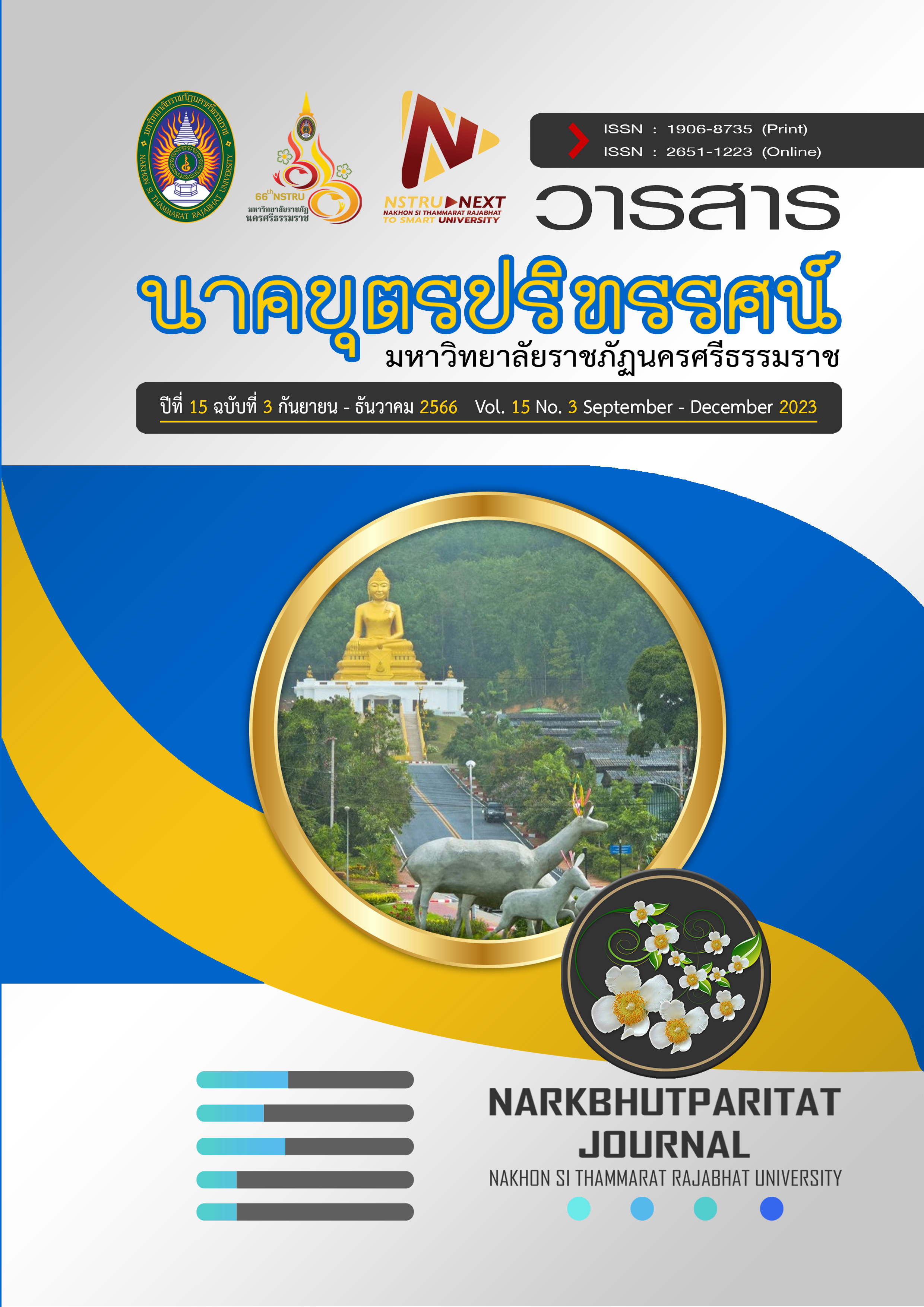The Service Model for Thai MICE Traveler a towards Lookmai Kiriwong Tourism Community Enterprise, Lansaka District, Nakhon Si Thammarat Province
Main Article Content
Abstract
This mixed-methods research aims to study the behavior of Thai MICE travelers, study their opinions on the service marketing mix that is important in choosing a study tour location, and propose an appropriate service model for Thai MICE travelers. The sample consisted of 400 Thai MICE travelers who used observational study services and were selected by accidental sampling, and 5 key informants were selected by purposive sampling. The research instruments were questionnaires and semi-structured interviews. Descriptive statistics analyzed quantitative data, inferential data was analyzed by t-test and one-way ANOVA, and qualitative data was analyzed by content analysis. The study found that Thai MICE travelers generally had the following behavior when using observational study services: they got information from social media; the organizations or educational institutions had a significant influence on their decision-making; and they studied for one day and participated in tie-dye activities. The study also found that the product is the most important factor in the marketing mix of services for selecting an observational study destination. The most chosen study tour location was the product area. The service model is appropriate according to the service marketing mix concept (7Ps), which includes products including tourism resources, lifestyles, souvenirs, and outstanding local food. The price is clear and the details of the service are clear. In terms of locations and distribution channels, there are geographic coordinates, improved road signs, and parking spots. In terms of marketing promotion, sales are publicized in online channels. In terms of process, standard services are provided. In terms of physical characteristics, there are natural and cultural identities. In terms of personnel, they provide service by being good hosts.
Article Details

This work is licensed under a Creative Commons Attribution-NonCommercial-NoDerivatives 4.0 International License.
References
Borisut, S. (2005). Investment Model: Tourism Business in MICE. Chiang Mai: Ploy Printing. (in Thai)
Dech-Um, P. (2009). Creative Tourism Development: Conceptual Framework to Practical Guidelines for Thailand. Silpakorn University Journal, 33(2), 329-364. (in Thai)
Lookmai Kiriwong Tourism Community Enterprise. (2022). Booking Record Plan of 2022 (Unpublished doctoral dissertation). Enterprise. (in Thai)
Ministry of Tourism and Sports. (2018). Vision of Thai Tourism in 2036. Retrieved 2021, October 2, from https://secretary.mots.go.th/ewtadmin/ewt/policy/ download/article/article_ 20170509151433.pdf (in Thai)
Office of the International Economic and Social Development Council. (2022). The 13th National Economic and Social Development Plan (2023-2027). Retrieved 2021, October 10, from https://www.nesdc.go.th/ download/document/Yearend/2022/PPT_NESDC.pdf (in Thai)
Office of the International Economics and Social Development Council. (2018). The 20-Year National Strategy. Retrieved 2021, October 15, from http://nscr.nesdc.go.th/ns/ (in Thai)
Pathan, A., Srithong, S. & Yodsuwan, C. (2022). Exploring MICE Travelers’ Desires and Perception on Marketing Mix Factors (7Ps) towards Community-Based MICE Activities. Journal of International Studies, Prince of Songkla University, 12(2), 230-275. (in Thai)
Sangpikul, A., & Kim, S. (2009). An Overview and Identification of Barriers Affecting the Meeting and Convention Industry in Thailand. Journal of Convention & Event Tourism, 10(3), 185-210. (in Thai)
Silpa-archa, W. (2002). Tourism Resource Management. Nonthaburi: Sukhothai Thammathirat Open University. (in Thai)
Sima, M., Thanabunyaset, T., Kamkaew, M. & Dechpan, A. (2021). Application of the concept of the marketing mix to promote Agri-tourism in Chiang Mai Province. Academic Journal Faculty of Humanities and Social Sciences, Phra Nakhon Rajabhat University, 5(2), 131-157. (in Thai)
Strategic Management office of Southern Provinces on the Gulf of Thailand. (2022). The Development Plan for Southern Provinces along the Gulf of Thailand in 2023-2027. Retrieved 2021, October 2, from https://drive.google.com/file/d/0Bw0uKlAnXKKn SXZ4UlsZmhsR0E/view?resourcekey =0.-dv6eLm9kmHKLiOAdJiBUzQ (in Thai).
Sukkasem, A. (2019). The Development of Guideline for Sport Tourism Management of Football Club. (Doctoral dissertation, University of Phayao) Retrieved 2021, October 2, from http://updc.clm.up.ac.th/handle/123456789/524 (in Thai).
Taro, Y. (1967). Statistics: An Introductory Analysis (2nd ed.). Harper and Row.
The Thailand Convention and Exhibition Bureau. (2020). TCEB is going to launch to promote the international exhibition. Retrieved 2021, October 2, from https://www. businesseventsthailand.com/th/support-solution/success-story/ detail/392-tcebs-5-strategies-to-promote-international-exhibitions-in-2021 (in Thai).
________. (2014). Introduction to MICE Industry. Author. (in Thai).
Thongklin, P., Limpradit, B., Teerakunpisut, S. & Bunlueng, P. (2019). Behavior and Perceptions of MICE Visitors on Marketing Mix: A Case Study of Summer Bitter Sweet 2018. (Doctoral dissertation) Dhurakij Pundit University. Retrieved 2021, October 2, from https://kb.psu.ac.th/psukb/handle/ 2016/13094 (in Thai)
Tirarat, S. & Phasunon, P. (2019). Analysis of readiness factor in secondary cities for decision making of MICE events in Thailand: Perspectives of business operators in the Central region, Northeastern and Southern regions. Rompruek Journal, Krirk University, 38(2), 21-33. (in Thai).


